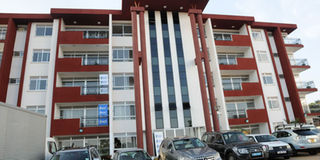NSSF puts high-end property on market

Luxurious. The luxurious Citadel Place apartments built by National Social Security Fund in Mbuya, Kampala. Each unit goes for Shs650m. PHOTO BY ERONIE KAMUKAMA
What you need to know:
Lubowa Housing Project that comprises of 2,741 housing units will be implemented in a maximum of 10 phases, over a period of 10 years.
A condominium housing project in the upscale residential area of Mbuya is expected to fetch Shs26b in revenue for National Social Security Fund (NSSF).
NSSF invested Shs14b in 40 units marketed as high-end apartments with four bedrooms, a CCTV security system, swimming pool, Wi-Fi, gym, club house and elevators.
Priced at Shs650m per apartment, NSSF is wooing big spenders such as Ugandans living in the diaspora, Kampala socialites and possibly retirees to make purchases. So far, 21 of these units have been sold off.
Speaking at the opening of the project known as the Citadel Place in Kampala, Finance State Minister in charge of General Duties Gabriel Ajedra, said the construction of modern apartments is appealing but NSSF must provide housing for all Ugandans.
“They [NSSF] need to look at the high-end, mid and low end options so that Ugandans can afford any of the houses,” he said.
However, Mr Richard Byarugaba, the NSSF managing director, said investing in an upmarket property at a time when there are calls for low cost housing and need to reduce Uganda’s 2.1 million housing deficit, was feasible given the cost involved in constructing houses.
“This is Mbuya so the land is expensive. We had to do the roads including to Kinawataka. We had to connect to the main sewers almost two kilometres away and set up a transformer. So the cost of infrastructure constitutes about 40 per cent of the project and 60 per cent is what we put in the building,” he said.
The Real Estate portfolio makes up 6 per cent of NSSF’s assets under management.
Fixed Income and Equities make up the rest at 79 per cent and 15 per cent, respectively as at June 30, 2019.
NSSF is undertaking different investments and these are planned to be less pricey. For instance, the Temangalo housing project on 463.87 acres of land will comprise of 5,000 affordable housing units and is expected to begin in 2020.
Lubowa Housing Project that comprises of 2,741 housing units will be implemented in a maximum of 10 phases, over a period of 10 years.
A project in Kyanja, comprising four levelled apartment blocks will accommodate a total of 160 units.
Low-cost houses still a distant dream
According to NSSF, a low cost house would be anywhere between Shs80m and Shs120m. To deliver that, it would have to forego infrastructure which means no roads, no water, no electricity and no sewerage system.
However, a quick check on the Shs14m, the average savings received by NSSF beneficiaries indicates not many savers could still afford a low cost house built by the Fund.
Mr Ajedra and Mr Byarugaba agreed that it will take high technology, cheaper land and government intervention to bring low cost houses to the market. Uganda could learn from Kenya and Tanzania.
“If government gives us land, provides roads, water systems and electricity, we would be able to bring down that cost to Shs50m,” Mr Byarugaba said.




